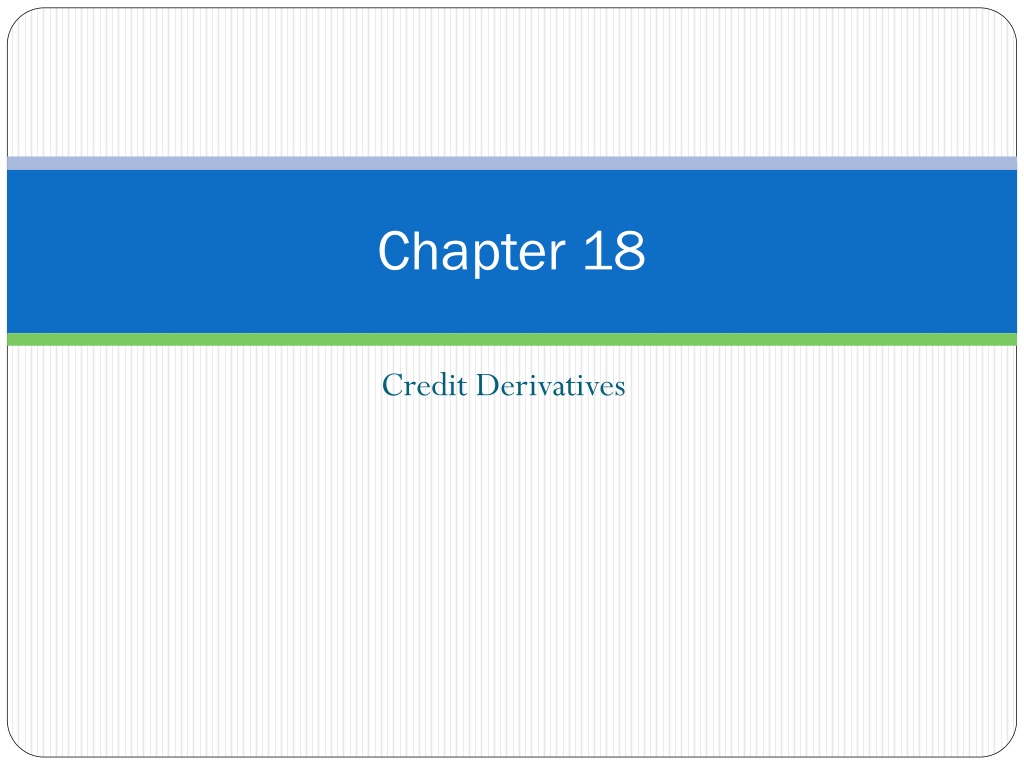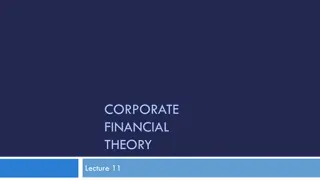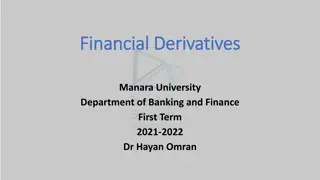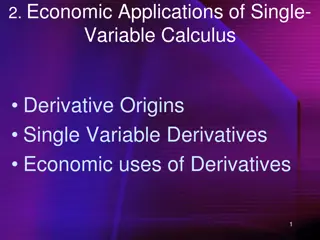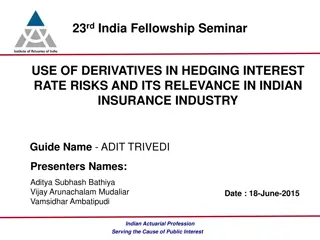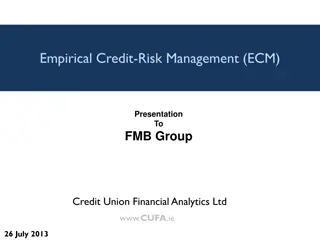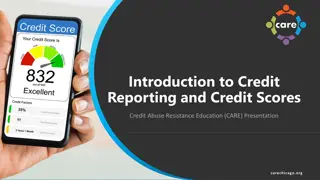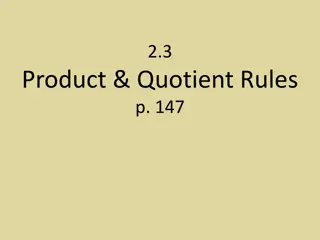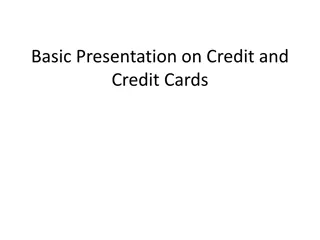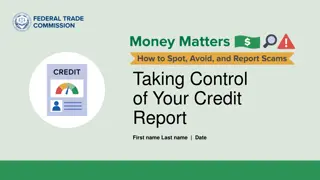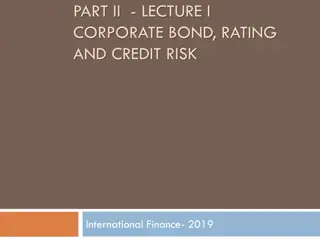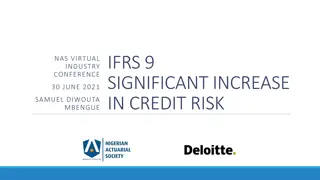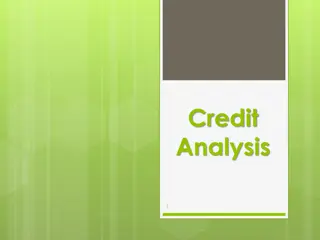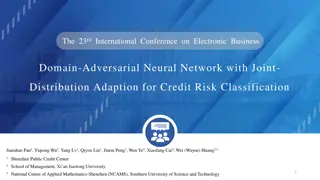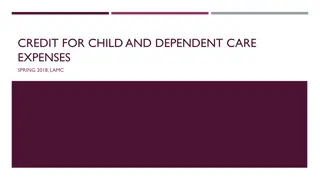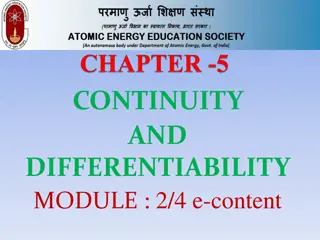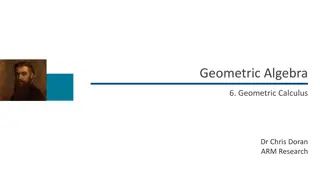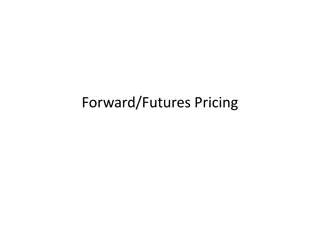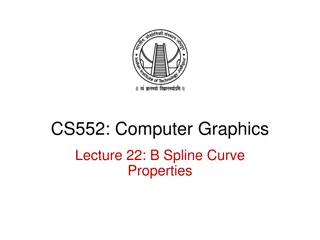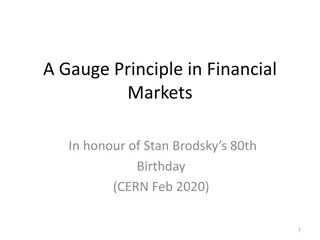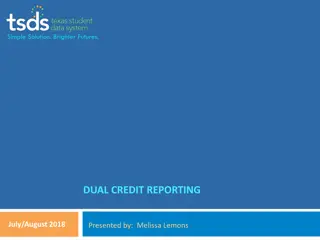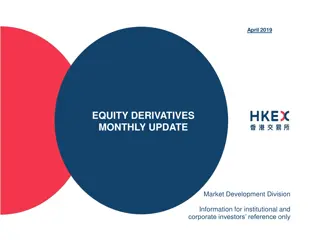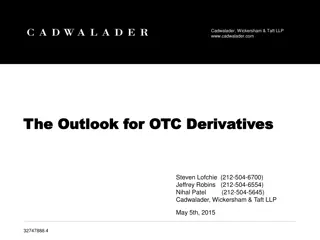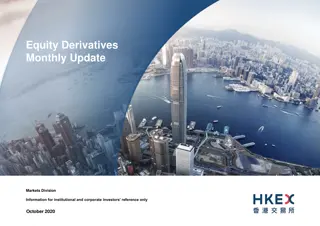Understanding Credit Derivatives and Managing Credit Risk
This chapter delves into credit derivatives, exploring their purpose, types such as credit default swaps and total return swaps, and the development of the market over the years. It discusses credit risk, problems associated with it, methods for estimating credit risk, and the role of credit derivatives in transferring credit risk between parties.
Download Presentation

Please find below an Image/Link to download the presentation.
The content on the website is provided AS IS for your information and personal use only. It may not be sold, licensed, or shared on other websites without obtaining consent from the author. Download presentation by click this link. If you encounter any issues during the download, it is possible that the publisher has removed the file from their server.
E N D
Presentation Transcript
Chapter 18 Credit Derivatives
Objectives of the Chapter Understanding what credit derivatives are The purpose of credit derivatives What are credit default swaps? What are total return swaps? What are credit options? What are credit-linked notes?
The Development of Credit Derivatives Packaging of mortgage bonds to create collateralized debt obligations Selling default protection in the 1990s as credit default swaps to trade credit risk Originally used by banks to hedge loan exposure Used by many investors and corporations and hedge funds Market size in 1996 was USD 180 billion; by 2006 it was USD 20,207 billion
Credit Risk Arises when one party promises to pay a given amount at a future time May arise in either loans or commercial transactions Default risk Risk of downgrading of credit rating Market risk
Problems with Credit Risk Value of the outstanding amount might decrease Difficult to calculate the probability of default or a negative credit event Difficult to estimate recovery rate
Estimating Credit Risk Estimate credit exposure, which is the expected dollar amount of loss if a negative credit event occurs This can be estimated using the value-at-risk model Estimate the probability of the occurrence of a negative credit event Credit risk is the product of credit exposure and the probability of a negative event occurring
Credit Derivatives Provide a means for transferring credit risk between two parties through bilateral agreements Could be based on a single credit or a diverse pool of credits which transfer risk on an entire credit portfolio Over-the-counter contracts are tailored to requirements, but in practice tend to be standardized Used by banks, insurance companies, hedge funds, security companies, pension funds, government agencies and corporations
Benefits of Credit Derivatives Hedge or mitigate credit exposure Transfer credit risk Generate leverage or enhance yield Separate risks embedded in securities such as convertible bonds Synthetically create loans or bond substitutes Actively manage credit risk on a portfolio basis Manage regulating capital adequacy ratios Decouple credit risk from funding
Structures of Credit Derivatives Credit default swaps Credit options Total Return swaps
Credit Default Swaps A bilateral contract in which one party, known as the protection buyer, pays a periodic fee on a notional amount in return for contingent payment from the other party, known as the protection seller Contingent payment will be made by the protection seller to the protection buyer if a specified credit event occurs with respect to the reference entity The periodic fee is usually expressed in basis points per annum A credit event is one in which the relevant obligations and settlement mechanisms to determine contingent payment are determined by negotiations between the parties to a contract ISDA Masters Agreements allow parties to specify the precise terms of transactions from a number of defined alternatives
CDS Terminology Credit event Contingent payment Notional value Protection buyer/seller Premium Tenure Settlement
Credit Event A contingency, the risk of which is transferred If this event occurs, protection payments will be triggered Six common credit events are: Bankruptcy (for non-sovereigns) and moratorium (for sovereign) Failure to meet payments when due Repudiation Obligation default Obligation acceleration Restructuring of debt
Contingent Payment If a credit event occurs, the protection seller must make payments for compensating the loss to the protection buyer The protection buyer need not have to suffer losses to receive a contingent payment Calculated as the decrease in the value of reference obligations below par value at some predetermined time after the credit event occurs Can also be fixed as a predetermined sum, in which case it is known as a binary settlement
Notional Value The notional value for computing the premium to be paid by the protection buyer and the contingent payment to be paid by the protection seller Usually standardized to USD 1 million There are contracts, such as amortizing loans, in which the notional value is not fixed, but rather decreases over time
Protection Buyer Entity that seeks protection against a credit event Entity such as a bank or financial intermediary Purpose is to hedge against credit risk inherent in credit assets like corporate loans, bonds and sovereign debt Similar to going short on the bonds as protection buyer gains if credit quality of the asset decreases Synthetically transferring a loan, avoiding problems of the actual sale of the loan
Protection Seller Motivated by yield enhancement, or by making gains from synthetic exposures to loans May also expect credit quality to improve Banks, insurance companies, hedge funds, equity funds, and investment companies act as protection sellers It could be either funded or unfunded product Until a credit event occurs, protection sellers make no financial investment, and are known as unfunded
Conversion of Funded to Unfunded Derivatives Protection seller prepays estimated protection payment to the protection buyer to be adjusted against contingent payment if a credit event occurs Otherwise, the money will be returned to the protection seller Protection seller places a deposit or cash collateral at the initiation of contract Protection buyer issues note, which is bought by the protection seller with a contingent repayment clause Whenever there is a cash outflow from seller to buyer at the time the contract is entered into, it is a funded derivative contract
Premium Amount paid by protection buyer to protection seller, for buying protection Usually paid over time Usually expressed in basis points If the premium is 50 basis points on a notional value of USD 1 million, the premium of USD 5000 will be paid Usually settled quarterly, but accrues on a daily basis May not be constant over time, but may increase over time to reflect term structure of credit risk, or for regulatory purposes
Tenure The term over which derivative contract will last Tenure will end either at maturity of the contract, or upon the occurrence of a credit event whichever comes first In a portfolio credit event, one of the obligations may not lead to termination of the contract Tenure need not have to coincide with maturity of the protection buyer s exposure Common for seller to provide protection for only a short period, rather than for the tenure of the underlying credit asset, with provision for step-up premium for the remaining period
Threshold Risk Some contracts are structured such that there is a threshold risk up to which losses are borne by the protection buyer Only when losses exceed this threshold limit is the protection seller required to compensate the buyer Also known as materiality loss provision
Settlement Takes place when credit event occurs Terms of settlement could be either cash or assets In the case of cash settlement, the seller will pay the contingent payment to the buyer, and the buyer will retain the ownership of the reference asset In the case of asset settlement, the buyer will deliver the assets of reference entity and receive par value for each asset delivered, limited to the notional value of the contract
Example of CDS Bank A provides a loan to Company X for INR 150 million, payable after 5 years Bank A enters into a credit default swap with fund P The notional value is INR 100 million, company X is the reference entity, the reference obligation is the bonds issued by company X Premium is 60 basis points over 3 years with a step-up premium of 75 basis points for years 4 and 5 Settlement will be an asset settlement
Counterparty Risk Protection buyer has transferred the credit risk of the reference entity to the protection seller The buyer holds the reference asset, but faces risk from the protection seller If a credit event occurs, the risk of the reference entity is not a concern for the protection buyer, but the risk of the protection seller Thus, credit risk is substituted by the counterparty risk
Synthetic Lending The protection seller is exposed to risks and rewards from the reference asset, even though they have not bought these assets If a credit event does not occur, the seller will continue to receive a premium, which is the reward related to the reference asset If a credit event occurs, the protection seller faces the risk of making contingent payments The seller will assume risk and reward of the original creator of reference assets without lending to him or her The credit asset is synthetic or unfunded for the protection seller
Contingent Credit Swap Hybrid credit derivative in which the contingent payment will be made only when the reference credit event occurs along with another bigger one This is a credit event with respect to another reference entity, or material movement in prices of equity, commodity or interest rate Protection is weaker, and hence cheaper than in a regular CDS Useful when there is low correlation between occurrences of these two triggers
Dynamic Credit Swaps Also known as credit intermediation swap Notional amount is linked to mark-to-market value of a reference swap or a portfolio of swap Notional amount used in calculation of contingent payments will be the marked-to-market value if contingent payments are positive Protection buyer pays a fixed fee, irrespective of size of protection provided Buyer will incur losses only if the swap counterparty and seller both default Employed to hedge exposure between margin calls on collateral posting, or to cover any loss beyond a pre-agreed amount Need not cover the full term of a swap Useful to hedge foreign currency denominated exposure
Total Return Swaps Bilateral contract to transfer credit risk from one party to another Exchanges the total economic performance of a reference asset for cash flow denominated in another asset, irrespective of whether or not a credit event will occur Payments in TRS are based on changes in the market valuation of a specific credit asset over the period of an agreement
Total Return Swaps, Contd Protection buyer will pay the protection seller the total return on specified credit assets or reference obligations The total return will comprise of the sum of interest payments, fees, and change-in-value payments of reference obligations If the total return is negative, the protection buyer will receive payments from the seller Change in value payments may be paid at fixed intervals, or at maturity These payments could be cash-settled, or through delivery of assets at maturity by the protection buyer for a payment of the reference obligation s initial value If the delivery of assets occurs, the protection seller will make a regular payment to the protection buyer on the basis of a reference rate
Total Return Swaps, Contd Can be used as synthetic financing vehicles for the protection buyer Protection buyer transfers the risk, but retains the rights under the reference obligation Protection seller is exposed to the reference obligation without purchasing the asset Can be considered as an instrument that provides secured financing to the protection seller to purchase reference assets imposed by the buyer
Total Return Swaps, Contd The spread on a TRS or premium over reference rate is the cost for the protection buyer for financing the reference obligation lent to the seller for the term of the contract
Credit Options Can be put options or call options on the price of a floating rate note or loan or asset swap Credit put provides the buyer with the right to sell a specified floating rate reference asset at a pre-specified exercise price Settlement can be done through cash or delivery of the physical asset In asset swap options, the put buyer will pay a premium for the right to sell the reference asset and simultaneously enter into a swap, in which a put seller pays coupon on reference asset and receive LIBOR puts strike spread The put seller will make an upfront payment of par value for the combined package upon exercise
Credit Options, Contd Can either be European or American type Can be structured to survive a credit event, in which case default risk and credit spread risk are transferred between two parties Can be structured as barrier options, in which the option is knocked out upon the occurrence of the credit event Option premium is dependent on market price volatility and not interest rate volatility Option premiums depend on the extent to which a strike spread is in-the- money, relative to forward credit spread curves
Credit Options, Contd Used for: Yield enhancement Downgrade protection Hedging future borrowing costs
Credit-Linked Note Funded balance sheet assets that offer synthetic credit exposure to a reference entity in a structure that resembles a synthetic corporate loan Issued by a special purpose vehicle that holds some form of collateral securities, financed through issue of notes Investors receive periodic coupons and face value at maturity if no credit event occurs by then Investors assume risk of reference entity as well as risk of underlying collateral assets If the reference entity defaults, collateral assets will be liquidated If the collateral assets default, investors are exposed to its recovery, irrespective of the performance of the reference entity High yield on credit-linked notes
Credit Derivatives and Financial Guarantee Products In regular guarantees, a guarantor will make payments only if the principal debtor defaults and the payment amount will equal the loss suffered. In a CDS, events such as bankruptcy and restructuring of debt are included, and payments could be different from actual loss In guarantees, there are three parties the debtor, the creditor and the guarantor. In CDS, there are only two parties, and the original debtor is not involved The guarantor receives a commission from the debtor; in CDS, the buyer pays periodic premiums to the seller The guarantor will become a creditor to the original debtor; in CDS, the seller has no rights against the original debtor unless the buyer delivers assets Guarantees are priced by the two parties and not traded; CDS are priced and traded in the market
